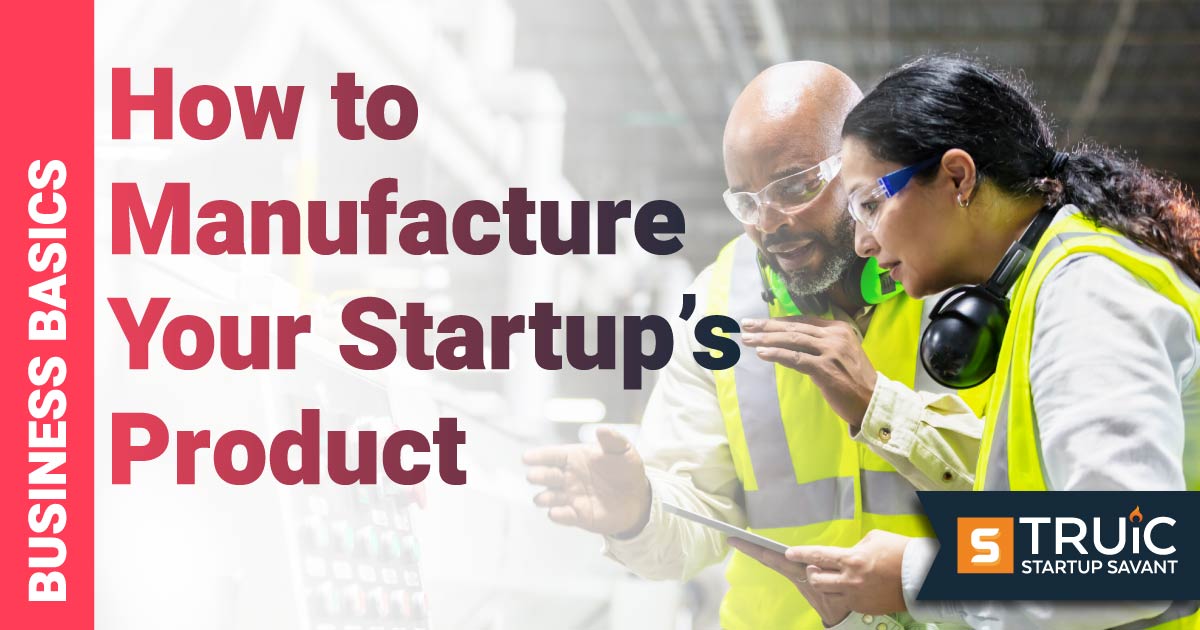How to Manufacture Your Startup's Product

Last Updated: By TRUiC Team
Building a solid, reliable product that your customers love is essential if you want your company to grow, thrive, and succeed in your industry over time.
Your product offerings will likely be the primary revenue drivers for your business. For this reason, you must take the time to understand the product creation and manufacturing process and take the time to confirm your product is the best it can be.
In this guide, we’ll discuss the process of manufacturing your startup’s product from start to finish.
While this process may seem difficult and overwhelming at first, it’s important to move forward step by step and take the time to understand each part of the process on a fundamental level.
When you and your team work together, divide up each part of the process among team members with particular strengths and focus on meeting the needs of your customers. Doing this will help ensure that your final product is on track to blow your market out of the water.
Manufacturing a Product
To offer a superior product to your customers, you’ll have to learn how to create a solid product concept, research your target market in detail, protect your intellectual property, and then transition into prototype creation and finding a long-term manufacturer for your business.
We’re going to walk you through each step of the product development and manufacturing process, allowing you to hit the ground running and avoid some common mistakes.
1. Create a Product Concept
The first step of the product development process is to create a product concept that captures your startup’s vision and solves the wants, needs, and desires of your customers.
A product concept is a detailed description of your product idea where you describe your future product from your customers' perspective.
Since your product concept is generated before you begin any detailed work on your product’s design, your concept should include all of your preliminary knowledge about your target market, what features you know your future customers want and need, and what pricing structure would work best for your market.
Once your conceptual product is complete and as detailed as possible, the next step of the process is to perform additional research on your target market.
2. Research Your Target Market
After your detailed product concept is complete, your next task is to do a “deep dive” into your target market and understand how potential customers would react to your future product. This can be done by getting direct feedback about your conceptual product and speaking with prospective customers and interested parties one-on-one.
Many entrepreneurs find the research phase of the product manufacturing process challenging since it involves seeking out the same audience you’ll be marketing to and asking them questions about how they would react to your product if it were available on the market today.
If you already have an email list or group of people you know in person who are in your target market, it’s best to start there.
To kick off this process, you and your team should:
- Understand the demographics of your target market (age, gender, education level, occupation, income, marital status).
- Narrow down several details or traits your prospective customers have in common.
- Create “personas” or fictional representations of your startup’s ideal customers. Many businesses like to start with three to seven personas.
- Give your personas a name, and make them as realistic as possible. The better your persona, the more of a feel you’ll have about proper messaging in your marketing efforts.
Once you’ve identified your ideal customers, you’ll want to reach out to individuals in the real world who match your personas and would be interested in purchasing your product.
Ask your ideal customers:
- What do you think of this product concept?
- Does it solve your problems?
- Does it meet your wants, needs, and desires?
- Would you purchase this product if it was available on the market today?
- What would you change about this product?
- Would you purchase this product for this price?
The research phase of product creation is arguably the most important, and it’s where we recommend spending the majority of your time.
If you don’t have a good “product-market fit” where your customers don’t resonate with your product and wouldn’t purchase it in the first place, why go through the rest of the product creation process?
This is your opportunity to validate and verify that your product meets your customer’s needs and desires before you even begin manufacturing, and if any major points of contention come up, you still have time to pivot and adjust your concept.
Take the time to do this part right, and it’ll pay off massively in the long run!
3. Protect Intellectual Property
Protecting your startup’s intellectual property is essential if you want to thrive in the marketplace and prevent your competitors from stealing your market share, especially if your product involves trade secrets and unique inventions.
One of the best ways your startup can protect your intellectual property as it relates to your product is through the patent filing process.
Patents are government licenses that protect your product from being used, made, or sold by others for a particular period of time. If you haven’t looked into the patent process, it’s worth consulting a patent attorney or getting an initial consultation about how you can protect your intellectual property even further.
4. Create a Prototype
Your product concept is complete, you’ve validated your ideas with your target market, and your startup has identified intellectual property protection strategies for taking your product on the market – what’s next?
At this point, you and your team can proceed with creating a prototype of your product and starting to build your creation in the real world.
Prototypes are often built in-house, but if your startup knows of a manufacturer that can assist with parts or components, that can help significantly speed up the process.
5. Find the Right Manufacturer
Once your prototype has been built and you have an ideal representation of what your product should look like in the real world, it’s time to find a manufacturer that can produce your product in bulk.
There are several factors you should consider when choosing a product manufacturer, including:
- Pricing: Does your manufacturer offer bulk pricing for producing a large number of units? If a custom mold is required, what is the cost? What are shipping costs?
- Logistics: How will your startup receive your products from the manufacturer? Where will your inventory be stored? Will you use a fulfillment center?
- Environmental Impact: Are there certain eco-friendly materials your manufacturer can use in your product? Are there eco-friendly shipping and packaging solutions you can pivot to?
Some resources that can assist you in finding manufacturers are:
- ThomasNet: A discovery network for manufacturers and suppliers
- IQS Directory: Industrial and manufacturing quick search
- Alliance for American Manufacturing: Find manufacturers to make your product in the USA
6. Test Your Product
Once you’ve found a manufacturer and received your initial product inventory, it’s time to rigorously test your product and ensure all of your product’s features are functioning as intended.
Test every bit of your product, and take the time to use it as a customer would. If there is anything that can be improved or modified, communicate with your manufacturer to make the necessary changes.


